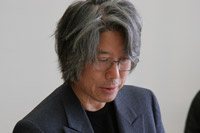Mamoru YONEKURA
Images behind the World
The jetliner and print are similar in that they travel around the world (says art historian TAKASHINA Shuji): I enjoyed jurying the entries for this triennial exhibition, as if I had traveled around the images of the world. I appreciate the “small art” (mini-print).
I just said “small art,” but “the grand art” must have been far poorer without this “small art.”
Words and images have continued to be two major media for information for long time, and images give concreteness to words. And yet, different from video art or photography, print art, provided with a nature of “formative expression,” is “the most avant-gardes” expressive medium that reveals the individuality of the tribal or personal imagination indigenous to each artist from different nations or regions. Thus, I thought I could say paradoxically that the world of“mini-print” keeps standing at the forefront of international exhibitions of art. I believe that the mini-print triennials are a fine project open to the world, one that should by all means be carried out as it was.
While judging the entries for the current triennial, necessarily possessing high quality, I noticed that the “small art” of the world has come near to the “painting” (the encounter between “print” and “painting” has a similar history to the encounter between Japan and the West). It could mean that the fusion of those two has already proceeded internationally.
Judging woodcuts, copper prints or mixed-media prints, I found not a few highly technical works from a viewpoint of formative expression, of which I could not tell the details of the technique.
The grand-prix piece by a Slovakian artist conveys to us a mysterious emotion of the people from the region that experienced the East European democratization: the work neither emphasizes lines (Western-art quality) nor denies color planes (Eastern-art quality), presenting an “apocalyptic” world in which both the lines and color planes are moderately fused. This grand-prix piece can have an artistic force to instill an image into viewers, even if not being informed of the motif of Andersen.
I have an image about Western prints in which everything is depicted with delicate lines only, and exactly shown in the case of copper prints, or, even in the case of woodcuts (for example, wood-engraving). To me, then, the semi grand-prix piece by a Japanese artist, too, was very refreshing. The piece, which killed “color” characteristic to the picture plane of Japanese prints like ukiyo-e, expresses an image of a momentary swaying. The stillness and a sense of color, nevertheless, are rich.
Rating high their formative expressions that can never leave “human-beings,” whatever subjects may be chosen, I selected two pieces by Viola TYCZ Jean DUNCAN as jury award pieces: I thought that the work by the Polish artist TYCZ, which is so fathomlessly grave and deep as to lose my words of description, intends to be imperfect as a picture, but, at the same time, intends to be perfect as an artwork. The work by the Northern Irish artist DUNCAN, on the other hand, has a beautiful image acquired not through the rhythm by the contrast of colors or movement of lines, but through the unexpected employment of aesthetic images, such as air or water. It is essentially a joyful work.
Judging from the number and variety of the entries, the scale of the current triennial project can be compared to that of traveling art across the world.
